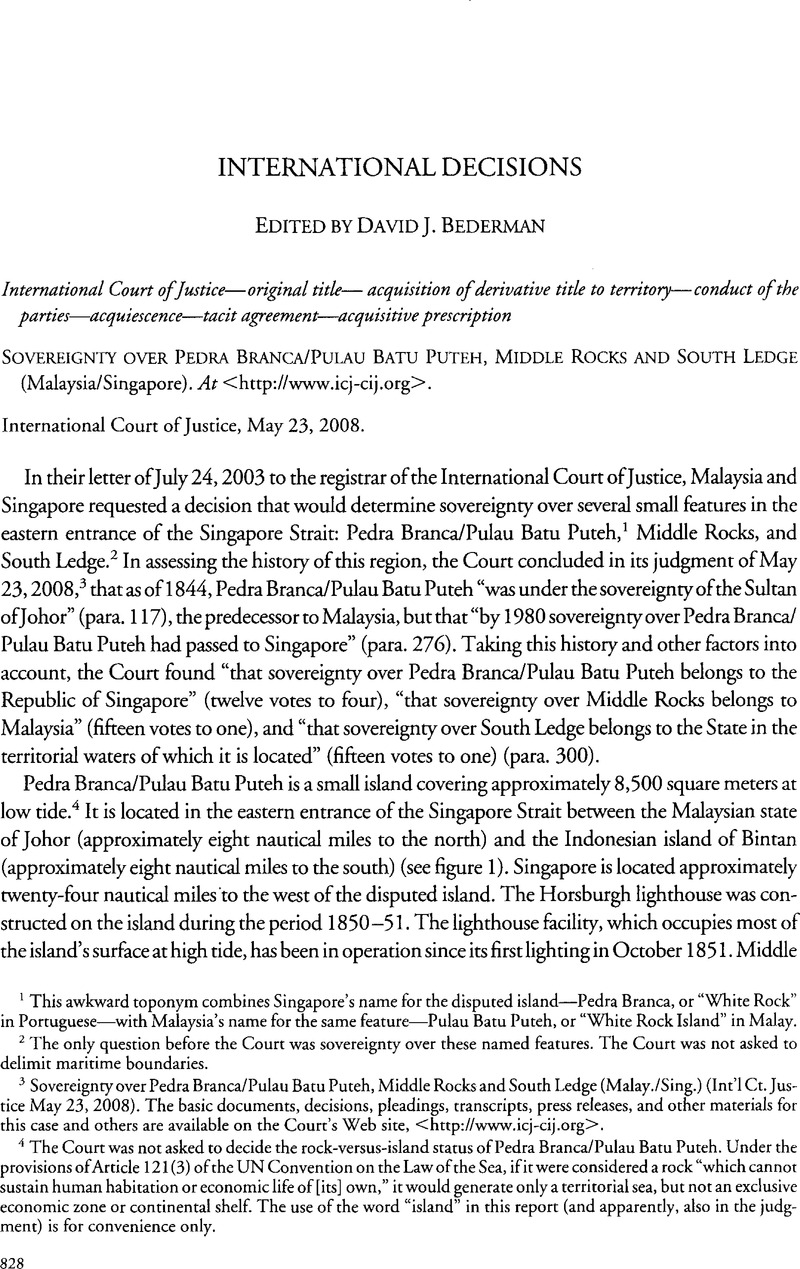Published online by Cambridge University Press: 27 February 2017

1 This awkward toponym combines Singapore’s name for the disputed island—Pedra Branca, or “White Rock” in Portuguese—with Malaysia’s name for the same feature—Pulau Batu Puteh, or “White Rock Island” in Malay.
2 The only question before the Court was sovereignty over these named features. The Court was not asked to delimit maritime boundaries.
3 Sovereignty over Pedra Branca/Pulau Batu Puteh, Middle Rocks and South Ledge (Malay./Sing.) (Int’l Ct. Justice May 23, 2008). The basic documents, decisions, pleadings, transcripts, press releases, and other materials for this case and others are available on the Court’s Web site, <http://www.icj-cij.org>.
4 The Court was not asked to decide the rock-versus-island status of Pedra Branca/Pulau Batu Puteh. Under the provisions of Article 121(3) of the UN Convention on the Law of the Sea, if it were considered a rock “which cannot sustain human habitation or economic life of [its] own,” it would generate only a territorial sea, but not an exclusive economic zone or continental shelf. The use of the word “island” in this report (and apparently, also in the judgment) is for convenience only.
5 The Court determined that February 14, 1980, the date of Singapore’s protest note, was the critical date with respect to Pedra Branca/Pulau Batu Puteh. The dispute over the other features did not crystallize until February 1993, when Singapore first claimed the features in discussions with Malaysia (paras. 34–36).
6 The Court notes that a temenggong was a “high-ranking official in traditional Malay states” (para. 21 n.l).
7 The 1927 Straits Settlement and Johor Territorial Waters Agreement—the 1927 Agreement—modified the Crawfurd Treaty by providing for the retrocession from Singapore to Johor of many of the islands first ceded in the Crawfurd Treaty. The Court concluded that Pedra Branca/Pulau Batu Puteh was not within the geographic scope of either the Crawfurd Treaty or the 1927 Agreement (para. 188).
8 Conduct in this category included: Singapore’s conduct related only to the maintenance and operation of the lighthouse, such as “improvement of the lighthouse [and] the exercise of authority over its personnel” (para. 165); the straits lights system and related British and Singapore legislation (paras. 166 - 80); constitutional developments and official descriptions of Singapore and Malaysia (paras. 181–89); Johor’s regulation of fisheries in the 1860s (paras. 190–91); naval patrols around Pedra Branca/Pulau Batu Puteh by Malaysia and Singapore (paras. 240 - 43); a Malaysian petroleum concession from 1968 (paras. 251–53); Malaysia’s territorial sea legislation of 1969 (paras. 254–56); the Indonesia-Malaysia continental shelf and territorial sea agreements of 1969 and 1970, respectively (paras. 257–58); the Indonesia-Singapore territorial sea agreement of 1973 (para. 259); interstate cooperation in the Singapore Strait (para. 260); and Singapore’s omission of Pedra Branca/Pulau Batu Puteh from lists in its official publications (paras. 261–62).
9 The parties were not able to produce the governor’s letters, but only the replies from Johor.
10 The Pulau Pisang comparison appeared elsewhere in the judgment. For example, the Court gave some weight to the fact that Singapore stopped flying its ensign over the lighthouse on Pulau Pisang at Malaysia’s request. No such request was made to lower the Singapore ensign flying above the Horsburgh lighthouse (para. 244). The Court also noted, in its assessment of Malaysia’s official maps that labeled Pedra Branca/Pulau Batu Puteh and the Horsburgh lighthouse “Singapore,” that this label did not appear with respect to Pulau Pisang (para. 269).
11 See, e.g., Sovereignty over Pulau Ligitan and Pulau Sipadan (Indon./Malay.), 2002 ICJ Rep. 625 (Dec. 17).
12 Three recent examples include Eritrea v. Yemen, First Stage, Territorial Sovereignty and Scope of the Dispute, paras. 449–50 (Perm. Ct. Arb. Oct. 9, 1998), Sovereignty over Pulau Ligitan and Pulau Sipadan, paras. 126–49, and Territorial and Maritime Dispute Between Nicaragua and Honduras in the Caribbean Sea (Nicar. v. Hond.), paras. 168–208 (Int’l Ct. Justice Oct. 8, 2007).
13 See Joint Diss. Op., Simma & Abraham, JJ., para. 13.
14 Although the Court did not refer to this mode as acquisitive prescription, it is difficult to see the difference between the Court’s “conduct/acquiescence” formulation and garden variety prescription: acquiescence requires publicity, and persistence of conduct seems to be implied. In any event, the three modes (tacit agreement, acquiescence, and prescription) are quite similar. See id., para. 16.
15 Judge ad hoc Dugard asked whether developing or evolving understandings were not just synonyms for tacit agreement. Diss. Op., Dugard, J. ad hoc, para. 19.